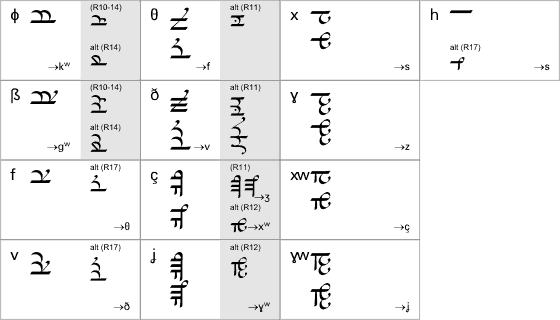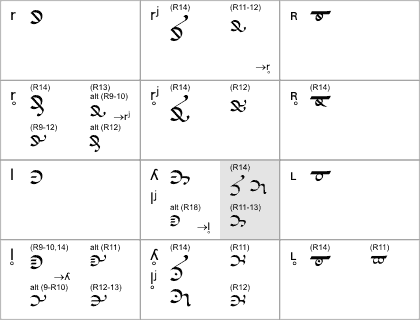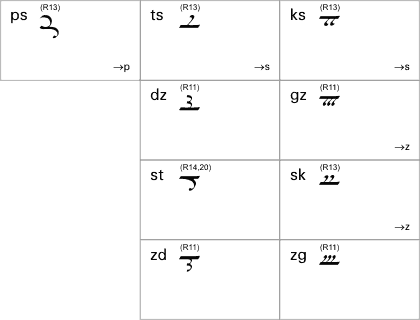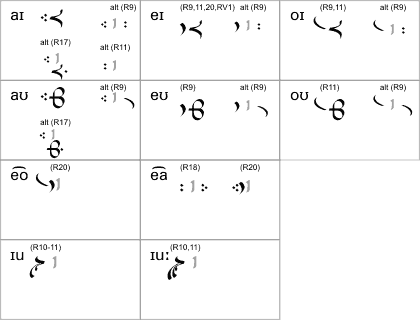The Phonetic Form boasts a greater number of sample documents than any other valuation. Of these documents, only three are actual Sarati texts (R20, R21, RV1): all the rest are descriptions of the script, dominated by lists of sarati and their sound values. Some of the descriptions also give a few individual words or short phrazes written with Sarati (R9, R10, R11, R16, R18, R19).
A few of the documents contain the most detailed and elaborate of Tolkien’s descriptions of the Sarati (R14, R17b, R18), listing a large number of glyphs that are not needed for the representation of English sounds. As a consequence of this, many exotic characters are found only in these lists, and not in any actual texts.
The Phonetic Form can be subdivided into three varieties, based on the use of certain glyphs for specific sounds.
For the purpose of this description, I consider the third variety to be the most “pure” version of the Phonetic Form.
The letters used in the Phonetic Form are shown in figure 1.
Figure 1: Consonant signs in the Phonetic Form.
In the top left corner of each cell, a sound value is written according to the
International Phonetic Alphabet.
To its right is given the most commonly used corresponding sarat, or one used in the third variety.
For more unusual forms or rarely attested sounds, references are given in parenthesis.
The text alt indicates that the sarat is given as an optional variant form.
The text final indicates that the sarat is used in word-final position.
The text error? indicates a possible mistake by Tolkien.
An arrow pointing at a phonetic symbol indicates that the sarat is attested for that sound as well.
Use of sarati that clearly belong solely with variety 1 are shown against a grey background.
Uses that are only found in variety 2 are shown within a dotted border.
1.1. Plosives

1.2. Non-sibilant Fricatives

1.3. Sibilants

1.4. Nasals

1.5. Semivowels or Glides

1.6. Liquids

1.7. Consonant clusters

The Phonetic Form uses diacritics to indicate double or long consonant, preceding nasal, and adjacent [s] or [z].
 Double or long consonant
is indicated by two dots or short dashes placed at the bottom of the sarat.
(In R18 the diacritic is indistinct,
and though it may be interpreted as two dots written hastily, other interpretations are possible.)
Note that this diacritic is identical with the vowel diacritic for [e] or
[i], which may be written at the bottom of sarati
in some circumstances (see further Vowels below).
Double or long consonant
is indicated by two dots or short dashes placed at the bottom of the sarat.
(In R18 the diacritic is indistinct,
and though it may be interpreted as two dots written hastily, other interpretations are possible.)
Note that this diacritic is identical with the vowel diacritic for [e] or
[i], which may be written at the bottom of sarati
in some circumstances (see further Vowels below).

In R10 and R11, a double consonant is indicated by a straight line running parallel with the bar line, either at the top or the bottom of the sarat. According to that system, it is possible to indicate a vowel between the two consonants by placing a vowel between the sarat and the doubling line. In the third variety, an identical diacritic is used to mark vowels as long.
 Preceding homorganic nasal (i.e. [m] before
[p] or [b],
[n] before [t] or [d],
and [ŋ] before [k] or [g])
is indicated by a cup-shaped diacritic placed at the bottom of the sarat.
Preceding homorganic nasal (i.e. [m] before
[p] or [b],
[n] before [t] or [d],
and [ŋ] before [k] or [g])
is indicated by a cup-shaped diacritic placed at the bottom of the sarat.
 In the third variety,
preceding [s] or [z]
is indicated by double dashes attached to the back of the sarat.
Following [s] or [z]
is indicated by a curl attached to the front of the sarat.
In the third variety,
preceding [s] or [z]
is indicated by double dashes attached to the back of the sarat.
Following [s] or [z]
is indicated by a curl attached to the front of the sarat.
In the first and second variety, separate diacritics of varying appearance are used for [s] and [z], as seen below.


Vowels are in the Phonetic Form represented by the diacritics seen in figure 2. According to R17, the phonetic form permits placing the vowel diacritics at the top of either the preceding or the following consonant “according to differ[ent] usages”. In the great majority of samples, however, the vowels are placed on the following consonant. It is only in R19 (and sporadically in RV1) that the vowel diacritics are placed on top of the preceding sarat. In R20, vowel diacritics may also be placed at the bottom of sarati; those are then pronounced after the consonant.
Figure 2: Vowel diacritics in the Phonetic Form.
Uses of diacritics belonging specifically with the first or second variety are given against a grey background.
An arrow pointing at a phonetic symbol indicates that the diacritic is attested for that vowel as well.

As figure 2 shows, R11 provides a larger number of diacritics to distinguish between the open-mid and close-mid pronunciation of e and o.

Vowels that have no consonant sign in the required position may be placed on top (or occasionally, bottom) of a short carrier, which has the shape of a short straight line. In the Phonetic Form, this line is usually parallel with the bar line, following the writing direction. But in a few documents, the carrier is given as perpendicular to the writing direction instead. In R17, this is given as an alternative to the usual form.
In English sarati texts, short unstressed vowels (usually pronounced as schwa [ə]) are often not written out. Also, the vowel is generally omitted in a few common one-syllable words, such as and (also in the Middle English text of R20), the, at, of, are, is. According to the description in R17, there are variants of the Phonetic Form where a specific vowel, typically [a] or [ə], “is implied in a consonant by usage”. In such variants, a consonant without a vowel is marked with a dot at the bottom of the sarat. No textual examples of this are known, however (but cf. the Quenya Usage, and the Classical Tengwar Mode).
Figure 3: Long vowels in the Phonetic Form.
Uses of diacritics belonging specifically with the first or second variety are given against a grey background.

Long vowels are written as shown in figure 3. As can be seen, the primary means of indicating a long vowel in the third variety is by imposing a straight line at the top of the sarat (in R11, an identical diacritic is used to indicate a repeated consonant).
The first and second varity presents other means of marking a vowel as long. Long [i:] and [u:] is indicated by placing a diacritic on the sarati for [j] and [w]. The sarat for [h] is also frequently used as a long vowel carrier.

Another method is to double the vowel diacritic: when the usage is to place vowel diacritics on top of the following consonant, the vowel is repeated at the bottom of the preceding consonant [R20]. When vowel diacritics are written on top of the preceding consonant, a second diacritic could possibly be added at the bottom of the same sarat, though we have no examples of this. Note that the double-dot diacritic representing [e] or [i] is identical to the diacritic used to mark consonants as long, which is always written at the bottom of sarati.
All these methods for indicating long vowels also occur either in earlier or in later valuations, and some occur in both (cf. The Early Form and The Late Form).
In R14, a peculiar vowel system for English is described. Since the description is both somewhat difficult to understand, and also incomplete, I have ignored it in this presentation. Suffice to say that some long vowels are distinguished by using the sarati for back [r] and [l] as vowel carriers.
Dipthongs are written two different ways in the Phonetic Form.
For falling, closing diphthongs, the first element may be written with a vowel diacritic, and the second with a sarat representing a semivowel — the front vowel [ɪ] is written with the same sarat as [j], and the back vowel [ʊ] is written with the same sarat as [w].
The second method is to write the diphthong as two consecutive vowels. This is the only attested way of writing centering diphthongs. In the description in R18, the first vowel is written on top of a carrier, and the second at the bottom of the same carrier. In earlier descriptions (belonging with the first variety), it is implied that where vowel diacritics are placed on top of the following consonant, the first vowel in the diphthong is written at the bottom of the preceding sarat. No known actual texts indicate diphthongs this way. In the Middle English text of R20, both vowel diacritics are placed on top of the sarat, with the first vowel inmost.
In R10 and R11, the sound sequence [ɪu] (like u in English use) is written with a diacritic that combines the sign for [u] with a mirrored version of the sarat for [j].
The attested methods for writing diphthongs are summarized in figure 4.
Figure 4: Diphthongs in the Phonetic Form.

Using the rules of the Phonetic Form as set out above, a text such as the following might be written:
Of the Valar and their kindred
At the beginning Ilúvatar, that is Allfather, made all things, and the Valar, or Powers, came into the world. These are nine: Manwe, Ulmo, Aule, Orome, Tulkas, Osse, Lórien, Mandos, and Melko.
Orome [and Tulkas] wǽron gingran on Ealfæderes geþohtum acende ǽr þǽre worolde gescepennisse þonne óþre fífe, [and] Orome wearð Iafannan geboren, séo þe wyrð æfter nemned, ac he nis Aules sunu.
— Rúmil, fragment from The Annals of Valinor, partially translated (by Ælfwine?) to Old English